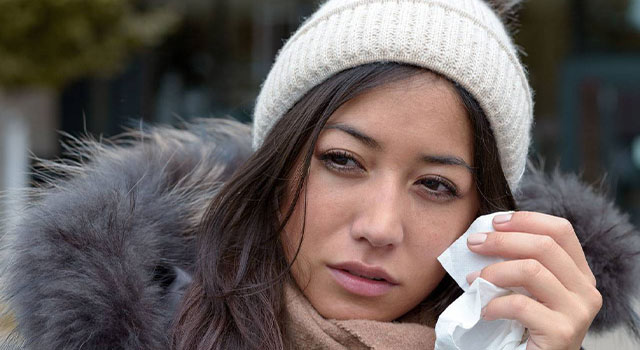 LASIK surgery is a remarkably safe and effective procedure. That said, no surgery is without risks, even if uncommon.
LASIK surgery is a remarkably safe and effective procedure. That said, no surgery is without risks, even if uncommon.
One of LASIK's side effects includes dry eye, characterized by dry, itchy, red, watery and gritty eyes. It is caused by insufficient tears or poor quality oil in the tears that prevent the eyes from being properly lubricated. Our eye doctors will guide and educate you on dry eye after LASIK so that you understand what to expect during the healing phase of the procedure.
Book an assessment at The Dry Eye Center At Eye Trends to determine your likelihood of developing dry eyes after the laser procedure and address the condition so you can fully enjoy clear vision.
What's Connection Between LASIK Surgery and Dry Eye?
During LASIK, a laser is used to cut a flap of the cornea, which lets the eye surgeon reshape the cornea with the laser.
Though we use the most advanced technologies to ensure the highest levels of safety and precision, creating corneal flaps can occasionally result in temporary damage to the corneal nerves. This causes the nerve impulses that control tear production to be interrupted. In most patients, as the cornea heals, the nerves heal as well, thus resuming regular and healthy nerve function. Flap complications are incredibly rare among those who closely follow the post-surgery instructions provided to them. However, if they do occur, our highly skilled eye doctor will address the issue and offer optimal treatment.
It is estimated that 50% of people who undergo LASIK surgery report dry eye symptoms in the following days and weeks. In the majority of cases, the dry eye symptoms subside on their own.
Some patients may have experienced dry eye symptoms before surgery. They might even have opted for LASIK due to discomfort when wearing contact lenses, not realizing that this discomfort might be caused by a pre-existing case of dry eye syndrome.
Whether the presence of dry, itchy eyes precedes LASIK surgery or is an aftereffect, it's important to assess the risks of developing or exacerbating dry eye syndrome following the procedure.
Are You At Risk for Post-LASIK Dry Eye?
Prior to undergoing LASIK surgery, you'll get a full eye exam. These tests may include:
- Tear breakup time tests
- Schirmer’s test
- Corneal imaging
- Tear osmolarity and inflammation
- Meibomian gland evaluation
A tear breakup test involves putting fluorescent dye on the surface of the eye to measure tear distribution and when the tears “break up.” For a Schirmer’s test, the doctor places a strip of paper under the eyelids to monitor tear production.
Corneal imaging uses non-invasive devices to assess the cornea and tear film without actual contact with the eye. The tear osmolarity and inflammation tests collect tears from the inside of the bottom eyelid to test protein levels that can signal a higher level of salt content and risk of inflammation in the tears.
What Increases the Risk of Developing Dry Eye?
- Aging
- Menopause
- Medications, including antihistamines
- Autoimmune diseases
- Hot, windy or dry conditions and climates
- Pollution or poor quality air
Older patients, particularly post-menopausal women, and those suffering from autoimmune conditions such as Sjogren’s syndrome, are more likely to have dry eye symptoms following the procedure. Those taking allergy medication and living in hot, dry climates should also take precautions.
How to Prevent Dry Eye Caused by LASIK Surgery
Your eye doctor may recommend the following for patients who are at high risk of developing dry eye syndrome after LASIK surgery as well as those who have pre-existing symptoms:
- Punctal plugs
- Omega-3 fatty acids
- Lubricating eye drops
- Prescription medication
- In-office treatments
Punctal plugs reduce eye moisture loss by blocking tear drainage tunnels. Omega-3 fatty acid supplements and lubricating eye drops can stimulate moisture in the eye before the procedure. Your eye doctor may prescribe eye drops or use a range of effective in-office dry eye treatments.
Schedule your appointment to assess your risk of dry and to discuss any questions you may have regarding LASIK and dry eye syndrome.
Our practice serves patients from Houston, Spring, Woodlands, and Conroe, Texas and surrounding communities.
Q: What Are Some Natural Remedies for Dry Eye Syndrome?
- A: Consuming foods rich in omega 3 fatty acids such as fatty fish and flaxseeds can stimulate the oils that are essential for tear quality. Warm compresses, gland expression and eye massage can often relieve clogged glands in the eyelids and provide relief. Maintaining eyelid hygiene and wearing protective sunglasses can also reduce symptoms.
Q: What Are the Most Common Dry Eye Symptoms?
- A: Along with dry eyes, some of the symptoms of dry eye syndrome may include redness, an itchy and burning feeling, stringy mucus, grittiness and excessive eye-watering.
